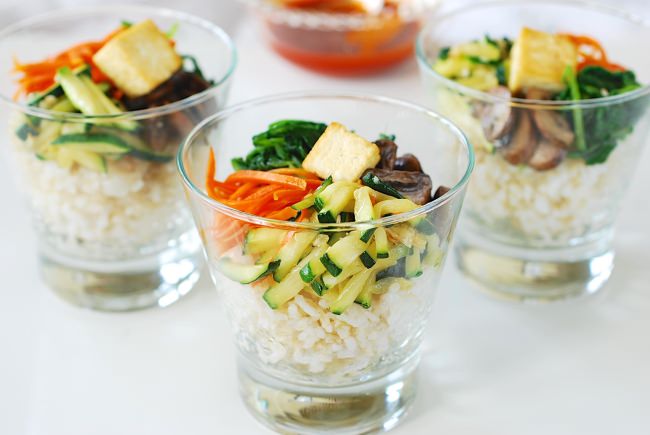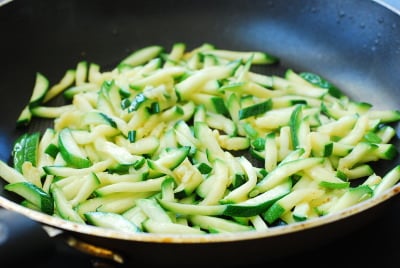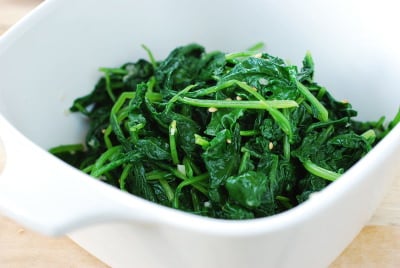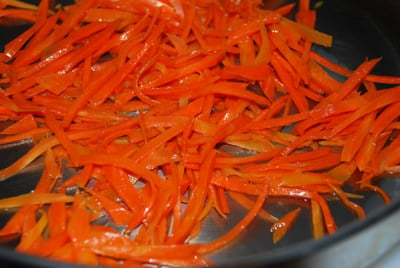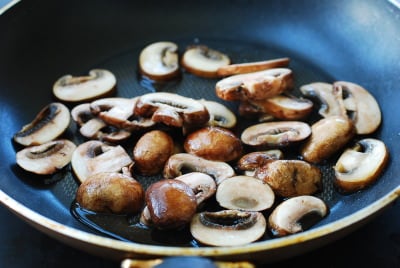One of the nice things about bibimbap is its versatility. It can be made in many different ways with any combination of vegetables and proteins. Whether you use leftover side dishes from previous meals or quickly cut up and blanch or saute whatever ingredients you have in the fridge, you will always end up with a whole satisfying meal!
I previously posted two bibimbap recipes on the blog – traditional bibimbap and tuna bibimbap. Here, I created a simple vegan bibimbap recipe with tofu as the protein choice.
The vegetables I used here can easily be found in your local grocery stores, so you can make bibimbap without a trip to a Korean market! You all have gochujang, right?
The vegetable choices are endless. I used zucchini, baby kale, carrots, and mushrooms. Other options are: cucumber, spinach, watercress, turnip greens, swiss chard, broccoli slaw, orange or red color bell peppers, red cabbages, etc.
For the gochujang sauce, I used a little bit of apple cider to thin it while adding a fruity sweetness. Korean plum extract will be great as well if you have it, or you can simply use sugar and thin it with water.
Who says bibimbap has to be served in a huge bowl? I recently attended a Korean event where bibimbap was served in small clear plastic cups. What a cute idea for a large group (also for your children)! Your picky eater might even eat a cup of bibimbap full of vegetables.
The tableware (except the glassware) shown in the final photos of this post are sponsored by Huue Craft, an online store dedicated to the finest Korean pottery tableware. They ship worldwide to over 25 countries. Visit Huue Craft online store for the beautiful tableware created by five of the renowned potters in Korea!


- 4 servings cooked rice
- 1 medium zucchini
- 5 ounces baby kale (or spinach or watercress)
- 2 medium carrots (or 1 orange bell pepper)
- 10 mushroom caps (crimini, white, or shiitake)
- 8 ounces tofu
- 1 teaspoon minced garlic
- sesame oil
- cooking oil
- 2 tablespoons gochujang
- 2 tablespoons apple cider (or 1 tablespoon Korean plum extract, maesilcheong and 1 tablespoon water)
- Cook the rice in a rice cooker or following package directions, using a little less water than called for. Rice for bibimbap should be slightly drier than usual for best results.
- Cut the zucchini into match sticks. Sprinkle with 1/2 teaspoon of salt, and let sit for 10 to 15 minutes. Squeeze out the liquid. Heat a pan with a little bit of oil. Add the zucchini and 1/2 teaspoon minced garlic. Sauté for 2 - 3 minutes over medium high heat. Stir in 1 teaspoon sesame oil.
![bibimbap]()
- Blanch the baby kale briefly in salted boiling water. Drain quickly, and shock in cold water. Drain again, and squeeze out the water. Toss with 1/2 teaspoon garlic, 1/2 teaspoon sesame oil, and salt and pepper to taste.
![bibimbap]()
- Cut the carrots into match sticks. Heat the pan again with a little bit of oil. Sauté the carrots for 1 - 2 minutes over medium high heat until slightly softened. Sprinkle with salt and pepper to taste.
![bibimbap]()
- Remove the stems off the mushrooms and cut into 1/4-inch thin slices. Sauté in the lightly oiled pan for 2 - 3 minutes over medium high heat.
![bibimbap]()
- Cut the tofu into about 3/4-inch cubes, and lightly sprinkle with salt. Heat the pan with a tablespoon of oil, and pan-fry the tofu until all sides are lightly golden.
![tofu bibimbap]()
- Place a serving of rice in a bowl. Nicely arrange a small amount of each prepared vegetable over the rice and top with a few tofu pieces. Drizzle a little sesame oil over. Serve with the red pepper paste sauce.
The post Tofu Bibimbap appeared first on Korean Bapsang.



